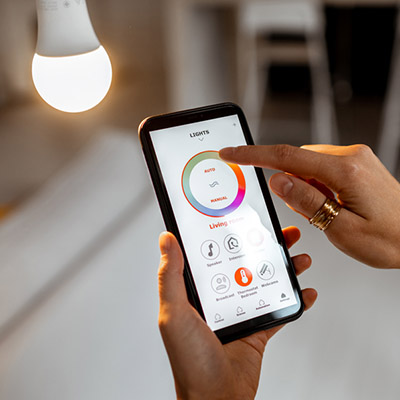Indoor Environmental Quality
At its core, the built environment (office buildings, homes, public buildings such as courthouses, movie theatres and schools) is for human occupancy and our activities. As we spend more and more time indoors, we expect a better and healthier life supported by our indoor environment. It is then especially important to balance these expectations with our desire to save energy and decarbonize buildings and systems.


As building technologies such as sensors progress, we expect that our indoor space becomes more than just a place to shelter us from the elements and dangers. We expect that the indoor environment will also provide us with a “wellness” lifestyle so that we can achieve greater work productivity as well as a better life.
Real Impacts of IEQ Indicators on Human Health
It is well known that good indoor air quality as well as a comfortable thermal, acoustical and lighting environment, are some of the more obvious indicators that have been traditionally measured to evaluate the performance of the building and its systems. This is true even though their impacts or the synergy of their impacts on human health are still not entirely understood. More research needs to be done to quantify the relationships between the measured IEQ parameters and the thresholds between a ”good” and a “bad” indoor environment quality. The research should then be verified and the imbedded into ASHRAE standards such as ANSI/ASHRAE Standard 62.1, Ventilation for Acceptable Indoor Air Quality


Relations between of IEQ Indicators and Wellness

Currently, due to ongoing discussions between engineers and researchers, wellness is harder to define, particularly as a parameter to be evaluated in a building. One can argue that the lack of negative emotions such as anger and fear, or the presence of positive emotions such as happiness and trust can be, and should be, qualified as indicators of “wellness.” However, it is right to question: Is wellness as experience by building occupants all about physical, emotional and spiritual sensations? Currently, these sensations and their different levels are hard to quantify objectively. More research should be done to better quantify these emotions and how the measured IEQ parameters are interrelated to them. Finding the correlations between the IEQ parameters of building performance and the degree of wellness experienced by the building occupants should be included in ASHRAE guidelines and best practices in order to guide in the future those engineers involved with renovation and construction of buildings.
Impact of Building Systems Performances on Wellness

Lastly, but not least, ASHRAE should help to develop the methods used to monitor, validate and record these links between the building systems performances and the wellness of its occupants. These methods will help to inform the continuous improvement in buildings, and in the understanding of the role that building systems can be critical to the wellness of the building occupants.
Indoor environment quality: a perceived indoor experience of the building indoor environment that includes aspects of design, analysis, and operation of energy efficient, healthy, and comfortable buildings. Fields of specialization include architecture, HVAC design, thermal comfort, indoor air quality (IAQ), lighting, acoustics, and control systems.
Indoor air quality (IAQ): attributes of the respirable air inside a building (indoor climate), including gaseous composition, humidity, temperature, and contaminants
Thermal comfort: the condition of mind which expresses satisfaction with the surrounding thermal environment and is assessed by subjective evaluation. Thermal comfort is affected by heat conduction, convection, radiation, evaporative heat loss, and relative air motion.
Acoustic environment: characteristics of a room that determine the qualities of sound therein, relative to hearing.
General lighting: lighting that provides a substantially uniform level of illumination throughout an area. General lighting shall not include decorative lighting or lighting that provides a dissimilar level of illumination to serve a specialized application or feature within such area.
Standards and Guidelines
ASHRAE 189.3-2017- Construction, and Operation of Sustainable High-Performance Health Care Facilities (ASHE co-sponsored; ANSI Approved)
ICC -- 2018 International Green Construction Code (IgCC) - STANDARD by International Code Council Publications, 2018.
Standard 113-2013 -- Method of Testing for Room Air Diffusion (ASHRAE/ANSI Approved)
Standard 129-1997 (RA 2002) -- Measuring Air Change Effectiveness
ASHRAE 154-2016 -- Ventilation for Commercial Cooking (ANSI Approved)
Standard 160-2016 -- Criteria for Moisture-Control Design Analysis in Buildings (ANSI Approved)
Standard 161-2018 -- Air Quality within Commercial Aircraft (ANSI Approved)
Standard 170-2017 -- Ventilation of Health Care Facilities (ANSI/ASHRAE/ASHE Approved)
Standard 185.1-2020 -- Method of Testing UV-C Lights for Use in Air-Handling Units or Air Ducts to Inactivate Airborne Microorganisms (ANSI Approved)
Standard 185.2-2020 -- Method of Testing Ultraviolet Lamps for Use in HVAC&R Units or Air Ducts to Inactivate Microorganisms on Irradiated Surfaces (ANSI Approved)
Standard 189.1-2020 -- Standard for the Design of High-Performance Green Buildings (ANSI Approved; USGBC and IES Co-sponsored)
Standard 202-2018 -- Commissioning Process for Buildings and Systems (ANSI Approved; IES Co-sponsored)
Standard 52.2-2017 -- Method of Testing General Ventilation Air-Cleaning Devices for Removal Efficiency by Particle Size (ANSI Approved)
Standard 55-2020 -- Thermal Environmental Conditions for Human Occupancy (ANSI Approved)
Standard 62.1-2019 -- Ventilation for Acceptable Indoor Air Quality (ANSI Approved)
Standard 62.2-2019 -- Ventilation and Acceptable Indoor Air Quality in Residential Buildings- (ANSI Approved)
Standard 90.1-2019 (I-P Edition) -- Energy Standard for Buildings Except Low-Rise Residential Buildings (ANSI Approved; IES Co-sponsored)
Standard 90.2-2018 -- Energy-Efficient Design of Low-Rise Residential Buildings (ANSI Approved)
Guideline 0-2019 -- The Commissioning Process
Guideline 10-2016 -- Interactions Affecting the Achievement of Acceptable Indoor Environments
Guideline 26-2012 -- Guideline for Field Testing of General Ventilation Filtration Devices and Systems for Removal Efficiency In-Situ by Particle Size and Resistance to Flow
Guideline 27-2019 -- Measurement Procedures for Gaseous Contaminants in Commercial Buildings
Guideline 28-2016 -- Air Quality within Commercial Aircraft
Guideline 29-2019 -- Guideline for the Risk Management of Public Health and Safety in Buildings
Research Projects
RP-1262 - Relate Air Quality and Other Factors to Comfort and Health Related Symptoms Reported by Passengers and Crew on Commercial Transport Aircraft (Part 1)
RP1262 - Relate Air Quality and Other Factors to Comfort and Health Symptoms Reported by Passengers and Crew on Commercial Transport Aircraft (Part 2)
RP-695 - Effects If Temperature And Humidity On Perceived Indoor Air Quality, Phase I: Air Contaminated By Materials
RP1596 - Ventilation and Indoor Air Quality in Retail Stores
RP1515 - Thermal and Air Quality Acceptability in Buildings that Reduce Energy by Reducing Minimum Airflow from Overhead Diffusers
RP1072 - Detection and Removal of Gaseous Effluents and Byproducts of Fungal Growth That Affect Indoor Environments
RP978 - Interaction of Room Air Motion and the Human Body in Confined Spaces
RP961 - Identification of Contaminants, Exposures, Effect and Control Options for Construction/ Renovation Activities, Phase II (804-RP \-- Phase I)
RP700 - Determine and Test Research Protocols for Evaluating the Relationship Between HVAC Systems and Productivity
RP740 - An Evaluation of the Effect of Co2 Based Demand Controlled Ventilation Strategies on Energy Use and Occupant Source Contamination Concentration
RP776 - Investigate and Identify Means of Controlling Virus in Indoor Air by Ventilation, Filtration Or Source Removal
RP1160 - Limited Criteria for Human Exposure to Low Humidity
RP1276 - A Study of Multiple Space Effects on Ventilation System Efficiency in Standard 62.1 -- 2004 and Experimental Validation of the Multiple Spaces Equation
RP1269 - Occupant Responses and Energy Use in Buildings with Moderately Drifting Temperatures
RP1257 - Indoor Environmental Effects On The Performance Of School Work By Children
RP1373 - Air Distribution Effectiveness with Stratified Air Distribution Systems
RP1522 - Establishment of Design Procedures to Predict Room Airflow Requirements in Partially Mixed Room Air Distribution Systems
RP1630 - Update the Scientific Evidence for Specifying Lower Limit Relative Humidity Levels for Comfort, Health and IEQ in Occupied Spaces
ASHRAE Transactions Papers
2017 - Can Using Active Air UV-C Technology Reduce the Amount of Bacteria and/or Fungus in the Air and Improve Indoor Air Quality?
2017 - The Impact of Traffic-Related Air Pollutants on the Indoor Air Quality of a Naturally Ventilated Building
2018 - Case Study: How to Handle a 50% Increase in Occupancy While Maintaining Indoor Air Quality
2018 - Case Study: Prestigious Event Center Achieves Sustainability Goals Using the Indoor Air Quality Procedure of ASHRAE 62.1
2018 - Nearly Zero Energy Schools: Their Systems, Energy Use and Perceived Indoor Air Quality
2018 - The Effects of Ventilation on Indoor Air Quality in Schools
2018 - Indoor Air Quality Modeling and Assessment
2019 - Indoor Air Quality (IAQ) and Energy Efficiency
2020 - Ventilation and Indoor Environmental Quality Perceptions in Post-War MURBs
2020 - Indoor Environmental Quality Evaluation of an Institutional Building
2020 - Investigating the Impact of Plant Phytoremediation on Indoor Air Quality in Work Environments: A Meta-Analysis
2020 - Seasonality and Trends in Indoor Air Quality Based on Continuous Monitoring
2021 - Review of the Effects of Indoor Air Quality on Occupants